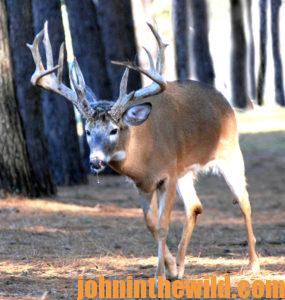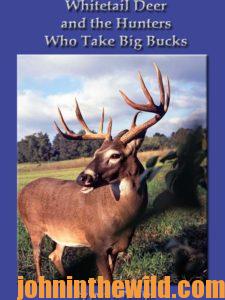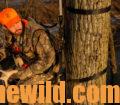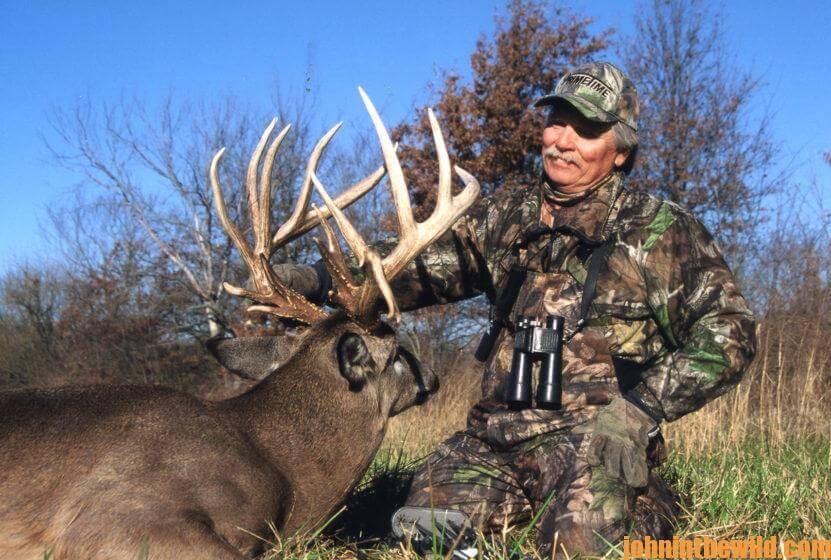Editor’s Note: When you first fall out of a tree and before you hit the ground, you have plenty of time to think about how stupid you’ve been, the mistakes you’ve made, and what you should have done to prevent the beating you’re about to take. I know from firsthand experience. I’ve fallen from tree stands on four different occasions, although not in recent years. The bruises, scratches, scrapes and loss of breath finally have taught me how important learning tree-stand safety is and how to keep from falling when I climb.
“In hunting seminars I teach, I’m frequently asked how I pick a stand site for an opening-day hunt, and my answer is quite simple,” longtime deer hunter Stan Potts, who’s taken several 200+ inch deer, explains. “The first thing I consider when I’m looking for a tree to put my stand in is which way is the wind blowing most often, and what wind direction do I have to have to hunt from this tree. If you don’t let the wind direction tell you which tree to put your stand in, then you can’t hunt effectively, and you’ll spook more  bucks than you take. In the Midwest where I primarily hunt, I’ll look for a tree that will allow me to hunt with either a south (south – southwest) wind or a north (north – northwest) wind because those are the dominant wind directions in my region. Next, I want to have the tree I’ll be hunting from in some type of frontal area or pinch point. Then the deer have to travel through that pinch point to get from their bedding area to their feeding area, from their feeding area back to their bedding area, or at a spot where they want to cross a creek. Remember, I’m hunting deer primarily with a bow, so I want to make sure that the tree I put my stand in will allow the buck to pass within 30 yards or less of my stand site.
bucks than you take. In the Midwest where I primarily hunt, I’ll look for a tree that will allow me to hunt with either a south (south – southwest) wind or a north (north – northwest) wind because those are the dominant wind directions in my region. Next, I want to have the tree I’ll be hunting from in some type of frontal area or pinch point. Then the deer have to travel through that pinch point to get from their bedding area to their feeding area, from their feeding area back to their bedding area, or at a spot where they want to cross a creek. Remember, I’m hunting deer primarily with a bow, so I want to make sure that the tree I put my stand in will allow the buck to pass within 30 yards or less of my stand site.
“If I pick my favorite tree for hunting, I’ll choose one that’s mostly trunks. By that I mean that the tree will have three or more trunks coming out of the same tree. A tree with several trunks coming out of it helps you hide better. Too, there’s less of a chance of a deer seeing you. Besides having three trunks, I want a tree that has several large clumps of limbs and branches around me. I think one of the most-critical elements to picking the right tree is having a tree you can hide in, as well as from where you can shoot. Many times when a deer looks up into a tree, if he can’t see you because you’re hiding behind some limbs, he won’t be spooked. But if you’re sitting in a tree stand on a tree that has very-few limbs and looks like a telephone pole, the deer easily can spot you when you make even the slightest move. So, in picking a tree-stand site, make sure you choose a tree that has enough cover for you to hide from the deer.
“Another mistake that deer hunters often make in picking a stand site for an opening-day hunt is they only pick one stand site. Then if anything happens that they haven’t planned for, their hunt is over. I want to have at least five stand sites and at least five different bucks that I can go to on opening morning based on wind direction. If on opening morning I’m planning to go to a stand site where I needed a south wind to hunt, but when I look on the Weather Channel I see that the region will have a steady north wind, then I need to go to another stand site to hunt. If I’m sitting on my stand site opening morning just before daylight, and another hunter walks right through the middle of my hunting area, I need to have another stand site I can go to and hunt, so that I don’t lose that day of hunting. On opening morning of deer season, try and have several different sites you can go to hunt that face various directions. Then regardless of the wind and weather condit ions or the hunting pressure, you have a stand site you can hunt from with confidence.
ions or the hunting pressure, you have a stand site you can hunt from with confidence.
“Don’t forget that deer don’t have allergies. Their noses don’t get stopped-up, and they don’t lose the ability to detect human odor. Even when you’re scouting and especially when you’re going to your stand on opening morning, be extremely scent-conscious. I always wash my hunting clothes with Scent-A-Way soap (https://www.hunterspec.com/scent-a-way). When I put my clothes in the dryer, I put a Scent-A-Way Fresh Earth Sheet in the dryer with my clothes, and when my clothes come out of the dryer, they go straight into my Scent Safe clothing bag. I usually drive to my hunting area wearing a pair of sweat pants and a tee shirt, so I can stay cool and not perspire or perspire very little. I take my Scent Safe bag to the tailgate of my truck, and I put my hunting clothes on in the outdoors. Each time I put on a layer of clothing, I spray down with Scent-A-Way.
“I put my tree stands up during the first two weeks of September. I sneak into my stand site, and I always try and go through the woods to where no one can see where I’m going or coming. Once I put my tree stands up, I’ll lock them onto the tree, so no one can take them. Then I take down the last two sections of my climbing sticks to keep someone from climbing into them and hunting from them. I usually try and hang my tree stands in the middle of the day, so that I can see if there are any deer at a food source before I go into the woods, and so no one else will see where I’m hunting. In the middle of the day, most people are either at work or eating lunch, and you won’t have as many people spotting you hanging your stands at this time of the day. I like to have my stands up four to six weeks before opening day of deer season. I believe you need to have enough stands already hung, so that the day can dictate which stand is best for taking an  older-age-class buck on the day you’re hunting. For instance, on a 500-acre farm, I’ll try and have 10 stands up with five stands placed. Then I can hunt on some type of south wind and five stands up so I can hunt on some type of north wind. By having this many stands up, then regardless of wind direction, I can have a stand that I can hunt confidently from every day I hunt.
older-age-class buck on the day you’re hunting. For instance, on a 500-acre farm, I’ll try and have 10 stands up with five stands placed. Then I can hunt on some type of south wind and five stands up so I can hunt on some type of north wind. By having this many stands up, then regardless of wind direction, I can have a stand that I can hunt confidently from every day I hunt.
“One of the most-critical keys to being able to hunt from a tree stand effectively is never walk to your tree stand from the same direction two consecutive times. Deer very easily can pattern the route you are taking to and from your tree stand, if you walk the same trail every time you go to that stand. So, every time I hunt from one particular stand, I approach that stand from a different direction. Another mistake that hunters often make going to or coming away from their tree stands is that they will walk across an open field or pasture. Deer aren’t stupid. If they see you walking across open ground, they know you’re in the woods, and you’re hunting. So, instead of going to your tree stand by the shortest route, walk inside the wood line. You may have to spend more time getting to your tree stand, but you’re less likely to spook the deer you’re attempting to take. Not only do I not want the deer to see me, I don’t want any hunter to see where I’m hunting or where I’ll be hunting.
“Another tactic I use during the early season is I make mock scrapes close to my stand. Besides the doe urine, I’ll put a little bit of dominant buck urine in that scrape. The reason I like to use the buck urine is because when any buck in that home core area smells that urine, he’ll be smelling a buck he can’t identify, which will cause him to be curious and to come by that scrape more often to find out what buck’s using that scrape. I believe making these boundary scrapes keep bucks coming in more often to check these scrapes to see who the new guy on the block is.” 
To learn more about hunting deer, check out John E. Phillips’ book, available in Kindle and print versions, and soon to be available in Audible December 1, 2019, “Whitetail Deer and the Hunters Who Take Big Bucks,” (http://amzn.to/2bYwYOK).










